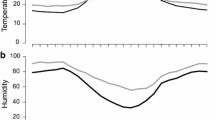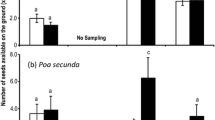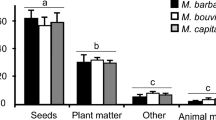Summary
Factors affecting local geographic distribution, foraging behavior and activity, forage selection, numbers of foragers per colony, nest spacing and nest structure ofPogonomyrmex rugosus andPogonomyrmex barbatus wer estudied. There were seasonal differences in foraging activity.P. barbatus was more active in early summer and foraged at night whileP. rugosus was more active in mid-summer foraging at night during July. Both species exhibited forage preference for grass seeds but took a variety of other materials. Where both species inhabited the same area they had an index of overlap for forage of 0.7. The colonics of both species were randomly distributed. Colony density was approximately 20 per hectare in areas supporting one or both species. There was no evidence of intraspecific aggression and foraging areas of colonies of the same species overlapped considerably.P. barbatus andP. rugosus avoid competition by habitat selection. Interspecific aggression probably accounts for the lack of overlap in local distribution.
Résumé
Nous avons étudié les facteurs qui influencent la dispersion géographique, le comportement et l'intensité de récolte, le choix de la récolte, le nombre d'ouvrières récolteuses dans chaque société, l'intervalle entre les nids ainsi que la structure des nids dePogonomyrmex rugosus et dePogonomyrmex barbatus. Nous avons décelé des variations saisonnières dans le comportement de récolte.P. barbatus s'est montrée plus active au début de l'été et a récolté la nuit, tandis queP. rugosus a présenté une pointe d'activité au milieu de l'été, la récolte de nuit se faisant en juillet. Les deux espèces ont manifesté une préférence pour les graines de graminées, mais ont récolté aussi d'autres matériaux. Là où les deux espèces cohabitaient, leur indice d'empiétement pour les récoltes était de 0,7. Les sociétés appartenant aux deux espèces étaient réparties au hasard. La densité des sociétés s'élevait à environ 20 par hectare dans les sites qui abritaient soit l'une soit les deux espèces. Aucune preuve d'agression intraspécifique n'est apparue bien que les territoires de récolte de la même espèce aient été largement imbriqués.P. barbatus etP. rugosus évitent la concurrence par le choix de l'habitat. L'agression interspécifique explique probablement l'absence d'empiétement des deux espèces dans la distribution locale des colonies.
Similar content being viewed by others
References
Brian (M. V.), 1961. — Ants and Termites, pp. 247–261.In: Phillipson, J., ed., 1971. Methods of study in quantitative soil ecology: population, production and energy flow. IPB Handbook, No. 18, Blackwell Scientific Publications, Oxford, 297 p.
Cole (A. C., Jr.), 1968. —Pogonomyrmex harvester ants. The University of Tennessee Press, Publ., Knoxville, Tennessee, 222 p.
Grieg-Smith (P.), 1964. — Quantitative plant ecology, 2nd ed. Butterworth Ltd., Publ., London, 256 p.
Hölldobler (B.), 1974. — Home range orientation and territoriality in harvesting ants. Proc. Natn'l.Acad. Sci. U.S.A., 71, 3274–3277.
Horn (H. S.), 1966. — Measurement of «overlap» in comparative ecological studies.Am. Nat., 100, 419–423.
Lavigne (R. J.), 1969. — Bionomics and nest structure ofPogonomyrmex occidentalis (Hymenoptera: Formicidae).Am. Ent. Soc. Am., 62, 1166–1175.
Lavigne (R. J.) andRogers (L. E.), 1974. — An annotated bibliography of the harvester ants,Pogonomyrmex occidentalis (Cresson) andPogonomyrmex owyheei Cole. University of Wyoming Agricultural Experiment Station. Science Monograph 26, 18 p.
Maker (M. J.), Dregne (H. E.), Link (V. G.) andAnderson (J. U.), 1974. — Soils of New Mexico. New Mexico State University Agricultural Experiment Station, Report 285, 132 p.
Phillips (E. A.), 1959. — Methods of vegetation study, Holt, Rinehart and Winston, Inc., Publ., New York, 106 p.
Pielou (E. C.), 1969. — An introduction to mathematical ecology. Wiley-Interscience, Publ., New York, 286 p.
Rogers (L. E.) 1974. — Foraging activity of the western harvester ants in the shortgrass plains ecosystem.Environ. Entomol., 3, 420–424.
Rogers (L. E.), Lavigne (R. J.) andMiller (J. L.), 1972. — Bioenergetics of the western harvester ant in the shortgrass plains ecosystem.Environ. Entomol., 1, 763–768.
Schumacher (A. M.) andWhitford (W. G.), 1976. — Spatial and temporal variations in Chihuahuan desert ant faunas.Southwest. Nat. (in press).
Schumacher (A. M.) andWhitford (W. G.), 1974. — The foraging ecology of two species of Chihuahuan desert ants:Formica perpilosa andTrachymyrmex smithi neomexicanus (Hymenoptera, Formicidae).Ins. Soc., 21, 317–330.
Sudd (J. H.), 1967. — An introduction to the behavior of ants. Edward Arnold Ltd., Publ., London, 200 p.
Whitford (W. G.), 1976. — Foraging behavior of Chihuahuan desert harvester ants.Amer. Midl. Nat. (in press).
Whitford (W. G.) andEttershank (G.), 1975. — Factors affecting foraging activity in Chihuahuan desert harvester ants.Environ. Entomol., 4, 689–696.
Wilson (E. O.), 1971. — The insect societies. Belknap Press, Publ., Cambridge, Ma., 548 p.
Author information
Authors and Affiliations
Rights and permissions
About this article
Cite this article
Whitford, W.G., Johnson, P. & Ramirez, J. Comparative ecology of the harvester antsPogonomyrmex Barbatus (F. Smith) andPogonomyrmex Rugosus (Emery). Ins. Soc 23, 117–131 (1976). https://doi.org/10.1007/BF02223846
Received:
Accepted:
Issue Date:
DOI: https://doi.org/10.1007/BF02223846




